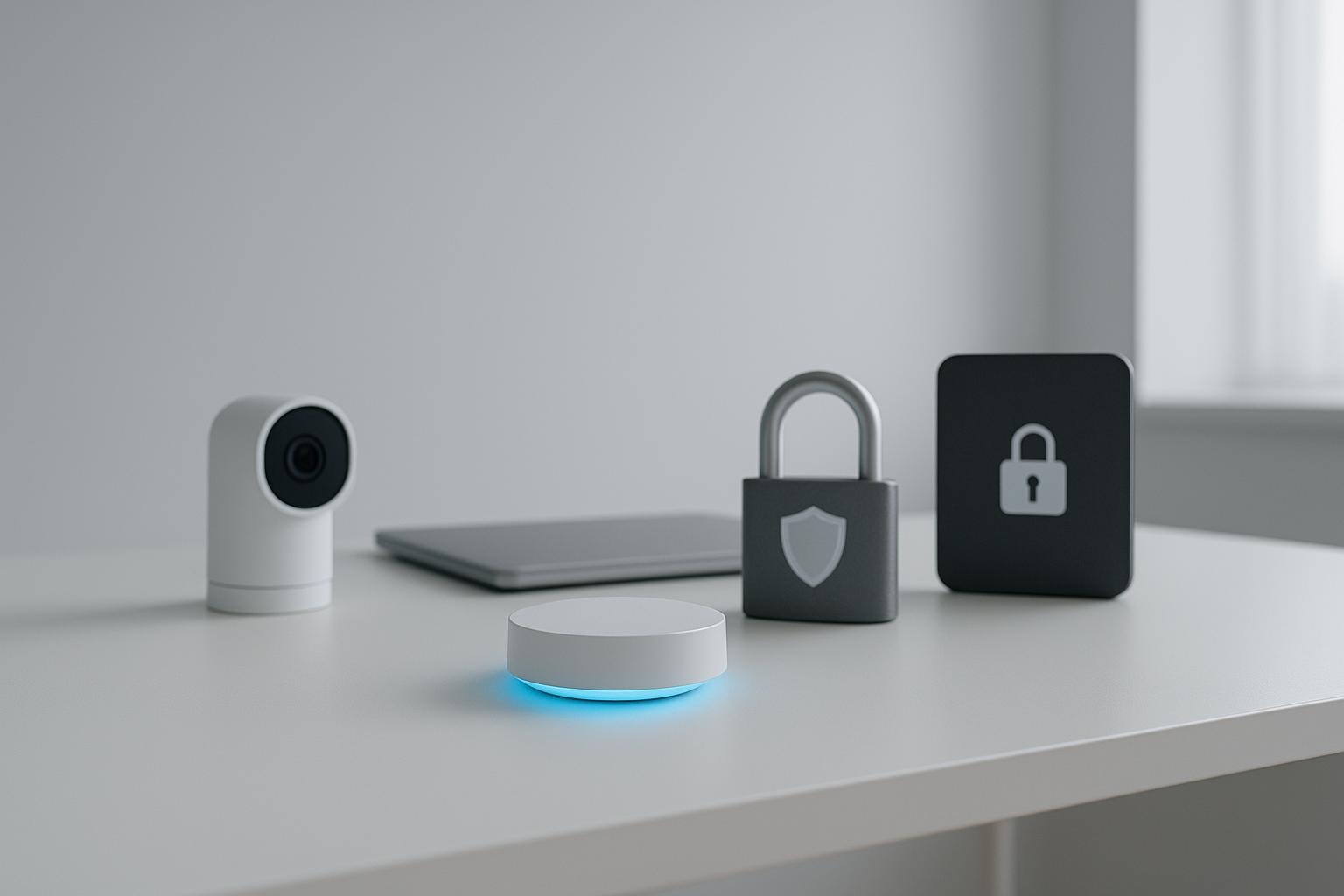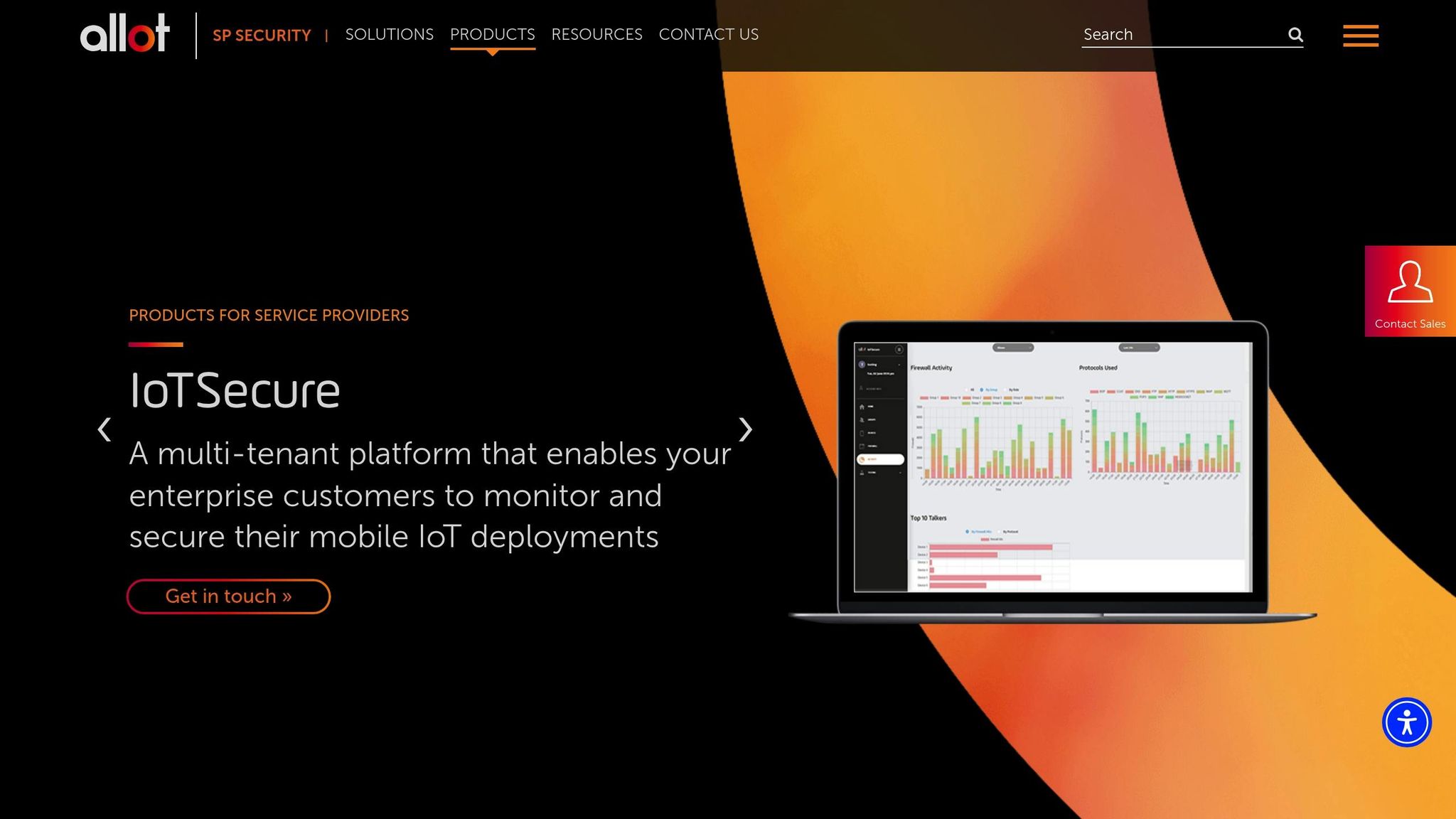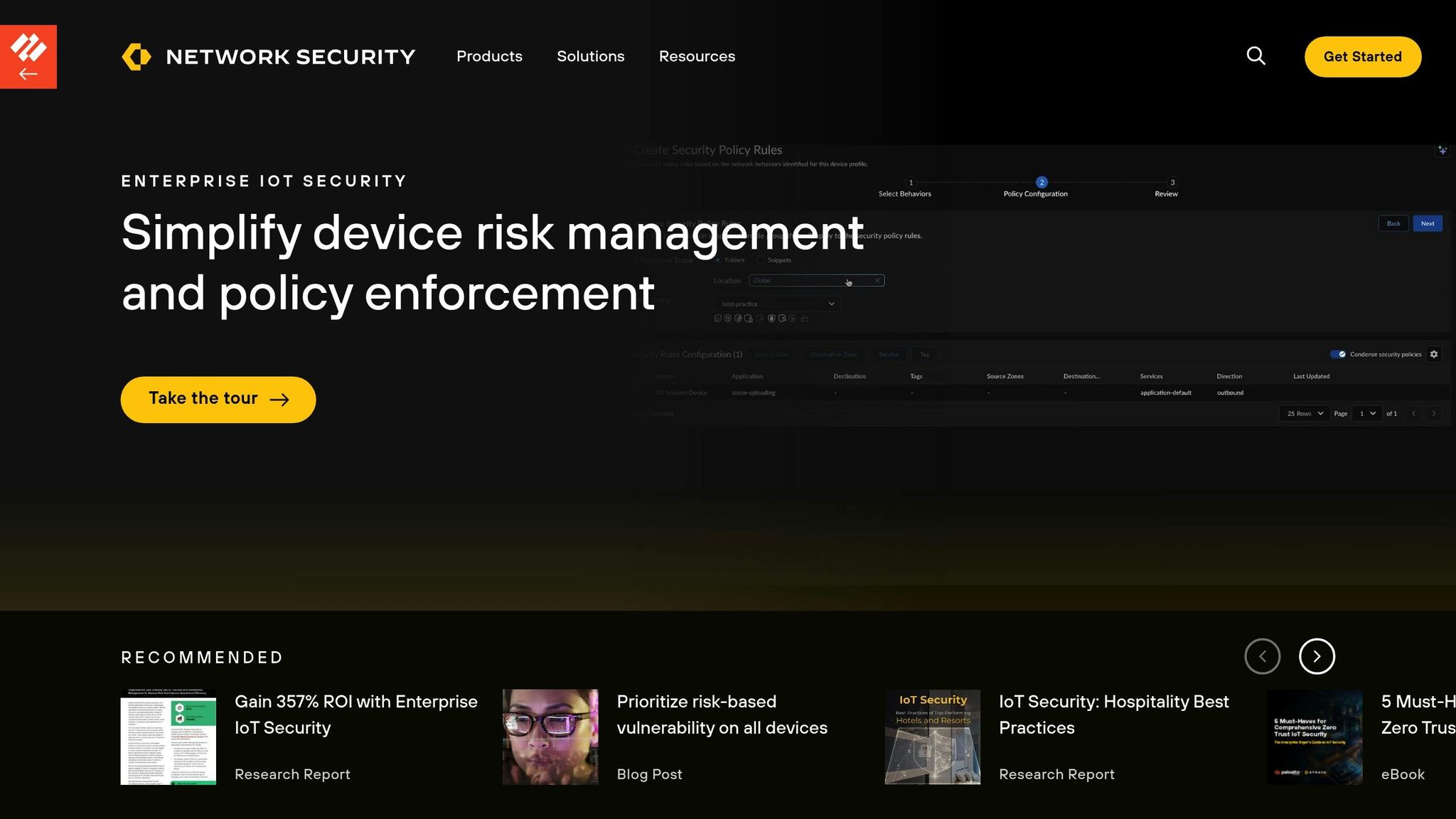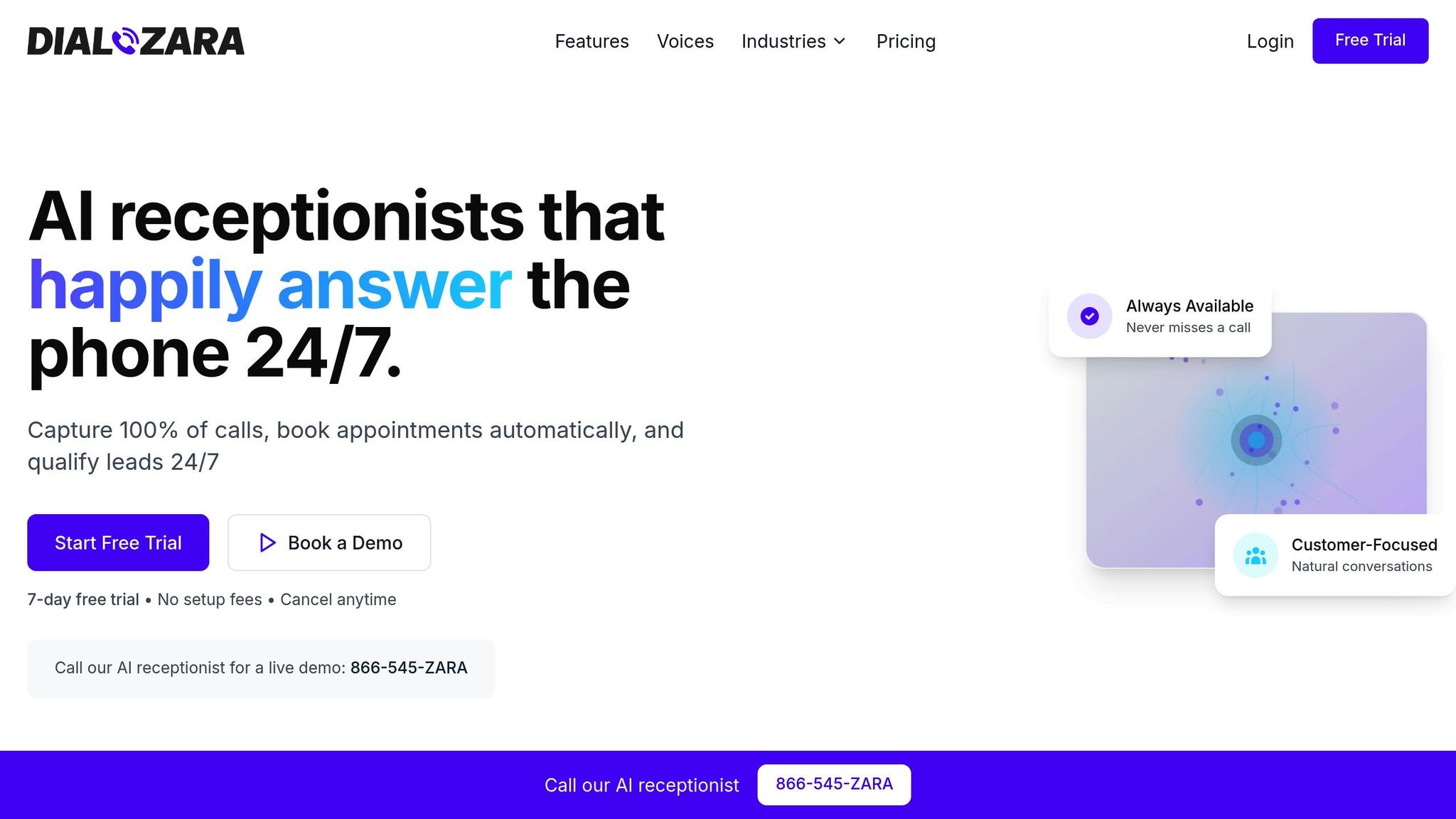
Top IoT Privacy Tools for SMBs in 2025
Small and medium-sized businesses (SMBs) face growing risks from IoT devices, with over half of these devices having critical vulnerabilities. Cybercriminals increasingly exploit outdated firmware, weak passwords, and unprotected networks, leading to costly breaches - averaging $330,000 per incident. In 2025, SMBs need privacy tools that balance strong security features with ease of use and affordability.
Key tools include:
- Allot IoTSecure Platform: Offers real-time monitoring, device protection, and cost-effective shared infrastructure.
- Palo Alto Networks IoT Security: Uses AI for device discovery, Zero Trust segmentation, and enterprise-grade compliance.
- Dialzara AI Communications: Focuses on privacy-first customer interactions with minimal data collection and quick deployment.
Quick Comparison:
| Feature | Allot IoTSecure | Palo Alto IoT Security | Dialzara AI |
|---|---|---|---|
| Focus | Mobile IoT networks | Enterprise IoT security | Customer communications |
| Key Strength | Real-time threat blocking | AI-powered device visibility | Minimal data collection |
| Compliance | Mobile carrier standards | Enterprise frameworks | HIPAA, GDPR readiness |
| Ease of Deployment | Carrier-dependent setup | Complex enterprise integration | Minutes to deploy |
| Cost | Shared infrastructure model | Higher enterprise cost | Up to 90% savings for SMBs |
To protect IoT systems, SMBs should also:
- Replace default passwords, enable two-factor authentication, and segment networks.
- Conduct regular audits to identify vulnerabilities.
- Train staff on privacy practices and update devices consistently.
What to Look for in IoT Privacy Tools
When it comes to IoT privacy tools, small and medium-sized businesses (SMBs) need solutions that provide strong protection while being easy to integrate and manage. The ideal tools should address specific vulnerabilities, align with budget constraints, and match the technical capabilities of the business. Here’s what to focus on when evaluating your options.
Data Anonymization and Masking
Protecting sensitive information is crucial, and techniques like data anonymization and masking play a key role. These methods ensure that even if data is exposed, it cannot be traced back to individuals or devices.
- Anonymization removes identifying details permanently, making it impossible to link data to its source.
- Masking, on the other hand, replaces sensitive data with realistic but fake information, allowing businesses to use the data for analysis without risking privacy.
Look for tools that offer various anonymization methods, such as aggregation, generalization, pseudonymization, and synthetic data generation. For SMBs managing customer data through IoT devices, these techniques allow you to maintain valuable insights while keeping privacy intact.
Real-time anonymization is another feature to prioritize. It ensures sensitive data is protected throughout its lifecycle. Tools that incorporate AI-driven automation can make the anonymization process more efficient and scalable as your IoT network expands.
And don’t forget encryption - it's a critical layer of protection for both stored and transmitted data.
Encryption Standards
Strong encryption is non-negotiable. Seek tools that provide end-to-end encryption, such as AES-256 or TLS 1.3, to protect data whether it’s being transmitted between devices, uploaded to the cloud, or stored in a database.
The best solutions are designed to work seamlessly, encrypting data automatically without slowing down operations or requiring advanced technical skills. Effective key management is equally important - look for tools that securely handle encryption keys and rotate them automatically. Together, encryption and anonymization create a solid foundation for IoT privacy.
For SMBs with limited IT resources, tools with secure default settings can be a lifesaver. They reduce the risk of misconfigurations and ensure your devices are protected right out of the box.
Beyond technical safeguards, compliance with legal standards is another critical aspect of IoT privacy.
Regulatory Compliance
Privacy regulations like GDPR, CCPA, and HIPAA come with hefty penalties, so SMBs need tools that simplify compliance. The right tools should include features like automated reporting, audit trails, and mechanisms to manage data subject rights. This minimizes the burden of manual compliance tasks.
Opt for solutions that integrate compliance frameworks addressing major privacy regulations. Features like automated compliance reports, detailed audit trails, and documentation ensure your business stays on the right side of the law.
It’s also important to consider the regional differences in privacy laws. For example, the EU’s GDPR provides a unified set of rules, while the U.S. has a mix of state-specific and industry-specific regulations. Tools with dynamic consent management can adapt to these varied requirements, ensuring user control over data collection in different scenarios.
Finally, robust documentation features are a must. Tools that automatically generate records like Data Protection Impact Assessments and audit trails save time and provide the evidence needed during regulatory audits. This not only helps maintain efficiency but also builds customer trust.
The stakes are high - data breaches affected 422 million individuals across nearly 2,000 incidents in 2022 alone. Choosing tools with strong compliance features can shield your business from legal risks and protect your customers’ privacy at the same time.
Best IoT Privacy Tools for SMBs
When it comes to safeguarding IoT devices, SMBs need tools that not only secure their networks but also address specific challenges. Here are some standout solutions designed to enhance privacy and security in IoT environments.
Allot IoTSecure Platform

The Allot IoTSecure Platform is a robust option for SMBs managing mobile IoT deployments. This platform offers real-time monitoring and protection, ensuring IoT devices are shielded from malicious activity. By blocking harmful communications and detecting compromised endpoints, it helps maintain network integrity.
One of its key features is the use of shared infrastructure to keep costs manageable while maintaining isolated security environments. Additionally, the platform provides detailed insights into device behavior, helping businesses spot potential threats before they escalate.
"IoTSecure protects IoT customers from infection and protects networks from rogue IoT device activity."
– Ran Fridman, Executive Vice President Worldwide Sales at Allot
Palo Alto Networks IoT Security

Palo Alto Networks IoT Security is designed to deliver AI-powered device discovery and classification, making it a great fit for SMBs. Using machine learning, it automatically identifies and catalogs every IoT device on the network, providing full visibility. This simplifies security management, especially for businesses with limited resources.
The platform’s Zero Trust segmentation ensures that even if a device is compromised, it cannot spread threats laterally across the network. This is especially important, as 57% of enterprise IoT devices are vulnerable to attacks. The system also flags devices with interfaces spanning multiple security zones, highlighting potential risks. Plus, it integrates seamlessly with tools like asset management systems and vulnerability scanners.
"Now, with Palo Alto Networks cloud-delivered IoT Security service, our IoT visibility is 100%. Automation and end-to-end security visibility allow us to work faster and focus on strategic security issues, not everyday alerts."
– Evren Buyer, Infrastructure and Operations Manager, Brisa
"As a CTO, I can easily manage known risk but what keeps me up at night is the unknown risk. Inherently we knew we had IoT devices on our network but couldn't easily identify, quantify, or classify the devices or risk associated with them. Having Palo Alto Networks IoT Security in place provides that visibility and affords us the ability to manage the risk appropriately."
– Duane Schell, Chief Technology Officer, State of North Dakota IT Department
The platform is also evolving into Strata Cloud Manager, offering additional capabilities.
Dialzara's Privacy-Preserving AI for Communications

Dialzara takes IoT privacy a step further by focusing on customer communications. Its AI-driven virtual phone answering service minimizes data collection, gathering only what’s necessary to complete interactions. This reduces risks tied to storing excessive customer data or conversation logs.
The platform ensures privacy by encrypting data throughout its lifecycle. It’s easy to deploy, requiring minimal configuration to train the AI on your business needs. With integration support for over 5,000 business applications, Dialzara fits seamlessly into existing IoT setups.
For industries like healthcare, legal, and financial services - where privacy breaches can have severe consequences - Dialzara offers a cost-effective solution, claiming up to 90% savings while providing 24/7 privacy protection. This is especially critical given that 43% of small businesses reported experiencing at least one cyberattack in the past year.
IoT Privacy Tools Comparison
When it comes to IoT privacy tools for small and medium-sized businesses (SMBs), the right choice depends on how well each tool aligns with specific needs. Below is a detailed comparison of three popular solutions, highlighting their unique approaches and features.
| Feature | Allot IoTSecure Platform | Palo Alto Networks IoT Security | Dialzara AI Communications |
|---|---|---|---|
| Data Anonymization | Network-level traffic masking | AI-powered device classification | Minimal data collection approach |
| Encryption Standards | Real-time communication encryption | Zero Trust segmentation | End-to-end data lifecycle encryption |
| Regulatory Compliance | Mobile carrier compliance | Enterprise-grade compliance frameworks | HIPAA, GDPR, and financial services readiness |
| Integration Capability | Mobile IoT infrastructure focus | Integrated with a broad range of enterprise tools | Integrates with over 5,000 business applications |
| Deployment Time | Carrier-dependent setup | Complex enterprise deployment | Minutes to deploy |
| Target Business Size | SMBs with mobile IoT | Medium to large enterprises | Small to medium businesses |
| Cost Structure | Shared infrastructure model | Enterprise licensing | Up to 90% cost savings |
Deployment and Integration
Each tool approaches deployment differently. Palo Alto Networks IoT Security requires significant IT resources for setup, making it ideal for larger enterprises with complex environments. On the other hand, Allot IoTSecure Platform simplifies deployment by leveraging mobile carriers, though this can limit flexibility. Meanwhile, Dialzara AI Communications stands out with its quick, hassle-free setup, taking only minutes to deploy.
Integration capabilities also vary. Dialzara supports over 5,000 business applications, making it highly versatile for SMBs. Palo Alto Networks integrates with a wide range of enterprise tools, while Allot focuses specifically on mobile IoT infrastructure.
Privacy Strategies
Privacy protection methods differ significantly. Allot emphasizes blocking malicious communications at the network level. Palo Alto Networks uses AI to identify devices and isolate threats, which is particularly effective in managing complex enterprise networks. Dialzara, however, takes a minimalist approach by collecting only essential data needed for customer interactions, prioritizing privacy.
Regulatory Compliance
Regulatory needs are another key consideration. For businesses in healthcare, legal, or financial sectors, Dialzara's readiness for HIPAA, GDPR, and financial services compliance makes it a strong contender. Palo Alto Networks offers broader compliance frameworks suited to larger enterprises, while Allot focuses on meeting mobile carrier regulatory standards.
Cost and Scalability
Cost structures vary widely across these tools. Dialzara delivers significant savings - up to 90% - making it particularly attractive for SMBs. Allot's shared infrastructure model also helps reduce costs, though it may not be as scalable. Palo Alto Networks, with its enterprise-grade features, comes with a higher price tag but offers robust capabilities for large-scale operations.
Tailored for Different Needs
Ultimately, each solution has its strengths. Allot is best suited for SMBs focused on mobile IoT deployments. Palo Alto Networks excels in securing complex enterprise environments, while Dialzara offers an efficient, scalable option for SMBs looking to manage growing communication needs without breaking the bank.
sbb-itb-ef0082b
How to Implement IoT Privacy in SMBs
Implementing IoT privacy in small and medium-sized businesses (SMBs) isn't just about using the right tools - it’s about creating a strategy that integrates privacy into daily operations from the very beginning. By embedding privacy into the design stage and maintaining ongoing vigilance, SMBs can better protect sensitive data and maintain trust.
Start by understanding your current setup. Take inventory of all IoT devices, classifying them based on the sensitivity of the data they handle and who has access to it. Document what each device collects, where the data is sent, and who can access it. This foundation is crucial for identifying risks and setting priorities.
Immediately replace default credentials on all devices and enforce two-factor authentication. Default credentials are an open door for attackers, so use strong, unique passwords for every device.
Another key step is network segmentation. Keep IoT devices on separate networks to limit the spread of potential breaches. If one device is compromised, segmentation helps contain the issue, preventing attackers from accessing other systems.
Conduct Regular Privacy Audits
Once basic measures like inventory, authentication, and segmentation are in place, it’s essential to conduct regular privacy audits. These audits help identify vulnerabilities and ensure your defenses are working effectively.
Monitor network traffic for unusual activity. Look for devices that behave oddly, such as communicating at unexpected times, sending data to unknown locations, or using an unusual amount of bandwidth. Continuous monitoring ensures you can catch and address threats in real time.
During audits, also review the security practices of third-party vendors. Your privacy is only as strong as the weakest link in your supply chain.
Use Privacy-by-Design Principles
Integrate security into your IoT systems from the start. This means minimizing data collection, encrypting data both in transit and at rest, and building multiple layers of defense. Instead of adding security measures after deployment, design them into your systems from the beginning.
Collect only the data you absolutely need, and retain it for as short a time as possible. If certain information isn’t critical to your operations, don’t gather it at all.
"Data minimization is fundamental to effective risk reduction. Organizations must develop a clear prioritization strategy - identifying their most critical assets and building targeted security measures around them." - Shrav Mehta, Secureframe
Adopt a defense-in-depth approach by layering security measures at the device, network, and application levels. This way, even if one layer is breached, others remain in place to protect your systems.
Train Staff on Privacy Protocols
Your employees play a critical role in maintaining IoT privacy. Educate them on cybersecurity best practices, enforce strict access controls, and ensure everyone is familiar with an updated incident response plan.
Training should include recognizing phishing attempts, using multi-factor authentication, and managing passwords securely. Tailor the training to different technical skill levels - while not everyone needs to be a cybersecurity expert, every team member should understand their responsibilities in protecting data.
Limit access permissions based on job roles, ensuring employees only access the information they need. This reduces the risk of accidental or intentional breaches.
Develop and share a clear incident response plan. Employees should know exactly what to do in the event of a breach, as quick action can minimize damage and help maintain customer trust.
For businesses in regulated industries, training should also cover compliance requirements like GDPR or HIPAA. With nearly three-quarters of countries worldwide implementing data protection laws, staying compliant is more important than ever.
Finally, ensure timely updates and patch management. Train your staff to recognize when firmware updates are needed and establish procedures for testing and applying patches across your IoT systems. Keeping software current is a simple but vital step in addressing vulnerabilities.
Conclusion: Protecting SMBs with IoT Privacy Tools
For small and medium-sized businesses (SMBs), ensuring IoT privacy isn't just a technical challenge - it's a necessity. The stakes are high, with risks extending far beyond financial losses to include potential damage to customer trust and overall business stability.
To address these challenges, SMBs need privacy tools that go beyond the basics. Advanced solutions, like the Allot IoTSecure Platform and Palo Alto Networks IoT Security, offer enterprise-level protection tailored to the needs of smaller businesses. These tools provide critical features such as data anonymization, strong encryption, and automated compliance with privacy regulations. They also deliver the network visibility and threat detection SMBs need to stay ahead of potential breaches. On the communications front, Dialzara showcases how privacy-preserving AI can improve both security and efficiency. With 60% of customers preferring to call local businesses but only 38% of those calls being answered, Dialzara ensures businesses don’t miss opportunities while maintaining rigorous data protection.
Beyond adopting these tools, implementing privacy-by-design principles, conducting regular security audits, and training staff on best practices are crucial steps. Considering that unpatched firmware accounts for 60% of IoT security breaches, keeping systems updated is non-negotiable.
As IoT adoption grows across industries, businesses that act now to prioritize privacy will position themselves for long-term success. Investing in these tools isn’t just about avoiding costly downtime - which averages 6.5 hours per incident - it’s about building a resilient foundation for growth in an increasingly connected world.
FAQs
What are the most important features to consider in IoT privacy tools for SMBs, and why do they matter?
When selecting IoT privacy tools for your small or medium-sized business, it's crucial to prioritize features like real-time monitoring, data encryption, access control, threat detection, and compliance management.
These tools play a key role in keeping sensitive information secure, blocking unauthorized access, and catching security issues as they arise. They also help your business stay aligned with privacy regulations, lowering legal risks and strengthening customer trust. By focusing on these functions, you can create a safer IoT environment while protecting your business.
What steps can SMBs take to comply with privacy regulations when using IoT devices?
To meet privacy regulations, small and medium-sized businesses (SMBs) should prioritize clear data practices and strong security protocols. Begin by developing straightforward privacy policies, obtaining explicit consent from users, and ensuring adherence to major regulations like GDPR and CCPA. Conducting regular security audits is critical for identifying and fixing potential weaknesses.
It's also important to thoroughly vet IoT vendors to confirm they comply with privacy standards and have solid risk management in place. By taking these proactive steps, SMBs can protect their operations and maintain customer confidence.
What are some practical steps SMBs can take to improve IoT network security beyond using privacy tools?
Small and medium-sized businesses (SMBs) can improve the security of their IoT networks by implementing network segmentation. This approach keeps IoT devices separate from critical systems, making it harder for unauthorized users to gain access. Pairing this with tools like firewalls and intrusion detection systems adds another layer of protection by monitoring and blocking suspicious activities.
To further safeguard your network, it’s important to keep device firmware updated, enforce strong authentication methods such as multi-factor authentication, and ensure secure management of APIs. On top of that, regular employee training on IoT security practices can reduce the risk of human errors and strengthen your overall defense strategy.
Related Posts
AI Data Privacy on Social Media: Key Challenges
Explore the challenges SMBs face in data privacy on social media and discover effective solutions for safeguarding customer trust.
Edge AI Security Checklist for SMBs
Secure your edge AI systems with essential strategies like Zero Trust networking, encryption, and AI-driven threat detection tailored for SMBs.
AI Privacy Trends in Smart Devices 2025
In 2025, SMBs must prioritize AI privacy to safeguard customer data, navigate complex regulations, and build trust amid rising cyber threats.
